| Listing 1 - 10 of 24 | << page >> |
Sort by
|
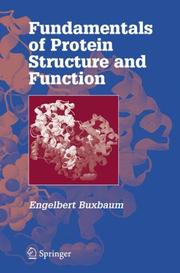
ISBN: 9780387263526 9780387684802 0387263527 0387684808 Year: 2007 Publisher: Boston, MA Springer
Abstract | Keywords | Export | Availability | Bookmark
 Loading...
Loading...Choose an application
- Reference Manager
- EndNote
- RefWorks (Direct export to RefWorks)
Fundamentals of Protein Structure and Function Engelbert Buxbaum, Dr. rer. nat. This book serves as an introduction to the fundamentals of protein structure and function. Starting with their make up from simple building blocks called amino acids, the 3-dimensional structure of proteins is explained. This is followed by an introduction into enzymology and modern concepts of enzyme kinetics, taking into account the physiological and medical significance of this often neglected topic. Also covered in the text are enzymes, biocatalysts, enzyme kinetics, hemoglobin, myoglobin, prion proteins, immunoproteins, motor proteins and movement, cell-cell interactions, molecular chaperones and chaperonins, transport of proteins into mitochondria, transport of proteins between cell compartments, transport of solutes across membranes, analytic techniques, protein-ligand interactions, protein purification, and protein structure, size and shape, emphasizing the link between protein structure, physiological function and medical significance. This book is an introductory text for researchers in protein biochemistry, molecular biology, cell biology, chemistry, biophysics and biomedical research. The book also makes an ideal textbook for graduate and advanced undergraduate courses in protein structure and function, and a supplementary text for related courses. About the Author Dr. Buxbaum is a biochemist with interest in enzymology and protein science. Dr. Buxbaum has been working on the biochemistry of membrane transport proteins for almost 20 years and has taught courses in biochemistry and molecular medicine at several universities. "The analytical descriptions of structure, biophysics and function of proteins is an extremely important aspect of today's education in biochemistry." Martin Sagermann, Ph.D. University of California, Santa Barbara
Proteins --- Structure --- Protein Conformation --- 577.122 --- 577.122 Protein metabolism --- Protein metabolism --- Conformation, Protein --- Conformations, Protein --- Protein Conformations --- Protein Folding --- Proteids --- Biomolecules --- Polypeptides --- Proteomics --- physiology --- Proteins - Structure
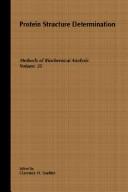
ISBN: 0471513261 9780471513261 Year: 1991 Volume: 35 Publisher: New York Brisbane Singapore Wiley
Abstract | Keywords | Export | Availability | Bookmark
 Loading...
Loading...Choose an application
- Reference Manager
- EndNote
- RefWorks (Direct export to RefWorks)
Protein Conformation. --- Proteins --- Structure-Activity Relationship. --- Conformation, Protein --- Conformations, Protein --- Protein Conformations --- Protein Folding --- analysis. --- physiology. --- Relationship, Structure-Activity --- Relationships, Structure-Activity --- Structure Activity Relationship --- Structure-Activity Relationships --- Analysis --- Structure --- Biochemistry --- Technique --- Structure-activity relationships (Biochemistry). --- Structure. --- Conformation. --- Analysis. --- Physiology.
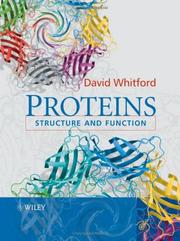
ISBN: 9780471498940 9780471498933 0471498947 0471498939 Year: 2007 Publisher: Chichester J. Wiley & Sons
Abstract | Keywords | Export | Availability | Bookmark
 Loading...
Loading...Choose an application
- Reference Manager
- EndNote
- RefWorks (Direct export to RefWorks)
"Proteins: Structure and Function is a comprehensive introduction to the study of proteins and their importance to modern biochemistry. Each chapter addresses the structure and function of proteins with a definitive theme designed to enhance student understanding. The latest developments in the field are included and key concepts introduced in a user-friendly way to ensure that students are able to grasp the essentials before moving on to more advanced study and analysis of proteins. An invaluable resource for students of Biochemistry, Molecular Biology, Medicine and Chemistry providing a modern approach to the subject of proteins."--Jacket.
Proteins --- Protein Conformation. --- Protéines --- chemistry. --- genetics. --- metabolism. --- Protein Conformation --- 577.122 --- 577.122 Protein metabolism --- Protein metabolism --- Conformation, Protein --- Conformations, Protein --- Protein Conformations --- Protein Folding --- Proteids --- Biomolecules --- Polypeptides --- Proteomics --- chemistry --- genetics --- metabolism --- Acqui 2006
Periodical
Abstract | Keywords | Export | Availability | Bookmark
 Loading...
Loading...Choose an application
- Reference Manager
- EndNote
- RefWorks (Direct export to RefWorks)
Proteins --- Enzymes --- Protein Conformation. --- Proteins. --- Enzymes. --- Protéines --- Périodiques. --- Biocatalysts --- Gene Products, Protein --- Gene Proteins --- Protein Gene Products --- Proteins, Gene --- Conformation, Protein --- Conformations, Protein --- Protein Conformations --- Ferments --- Soluble ferments --- Molecular Mechanisms of Pharmacological Action --- Protein Folding --- Catalysts --- Enzymology --- Biocatalyst --- Enzyme --- Protein
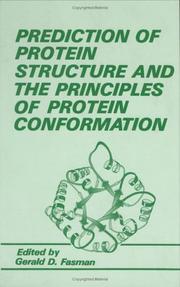
ISBN: 0306431319 1461288606 1461315719 9780306431319 Year: 1989 Publisher: New York, NY : Plenum Press,
Abstract | Keywords | Export | Availability | Bookmark
 Loading...
Loading...Choose an application
- Reference Manager
- EndNote
- RefWorks (Direct export to RefWorks)
With the applications of prediction gaining momentum in fields such as enzymology and immunology, this volume presents an evaluation of present methods of expounding the various algorithms. These, when utilized on PCs or larger computers, can instantaneously take a primary amino acid sequence and produce a two- or three-dimensional image of the str.
Proteins --- Protein Conformation --- MODELS, MOLECULAR --- Conformation --- ultrastructure --- Conformation. --- Structure --- Mathematical models. --- Proteids --- Biomolecules --- Polypeptides --- Proteomics --- Protein conformation --- Structure&delete& --- Mathematical models --- Proteins - Structure - Mathematical models. --- Proteins - Conformation. --- Models, Molecular --- Conformation, Protein --- Conformations, Protein --- Protein Conformations --- Protein Folding --- Molecular Models --- Model, Molecular --- Molecular Model --- Molecular Conformation --- Molecular Structure --- Proteins - Conformation --- Proteins - ultrastructure --- PROTEINS --- PROTEIN CONFORMATION --- PROPERTIES
Book
ISBN: 0128167327 0128163488 9780128167328 9780128163481 Year: 2019 Publisher: London
Abstract | Keywords | Export | Availability | Bookmark
 Loading...
Loading...Choose an application
- Reference Manager
- EndNote
- RefWorks (Direct export to RefWorks)
"Intrinsically Disordered Proteins: Dynamics, Binding, and Function thoroughly examines and ties together the fundamental biochemical functions of intrinsically disordered proteins (IDPs) and intrinsically disordered regions (IDRs), including signaling, binding, and regulation, with the methodology for study and the associated pathways for drug design and therapeutic intervention. The role of new mechanistic, computational, and experimental approaches in IDP study are explored in depth, with methods for the characterization of IDP dynamics; models, simulations, and mechanisms of IDP and IDR binding; and biological and medical implications of IDP dynamics prominently featured. Written and edited by leading scientists in the field, this book explores groundbreaking areas such as ensemble descriptions of IDPs and IDRs, single-molecule studies of IDPs and IDRs, IDPs and IDRs in membraneless organelles, and molecular mechanisms of fibrillation of IDPs. Intrinsically Disordered Proteins provides students and researchers in biochemistry, molecular biology, and applied microbiology with a comprehensive and updated discussion of the complex dynamics of IDPs and IDRs."--
Proteins --- Structure. --- Intrinsically Disordered Proteins --- Carrier Proteins. --- Protein Conformation --- physiology. --- Conformation, Protein --- Conformations, Protein --- Protein Conformations --- Protein Folding --- Binding Protein --- Binding Proteins --- Transport Proteins --- Protein, Binding --- Proteins, Binding --- Proteins, Carrier --- Proteins, Transport --- Protein Binding --- Receptors, Transferrin --- Carrier Protein --- Transport Protein --- Protein, Carrier --- Protein, Transport
Book
ISBN: 9781584886839 1584886838 Year: 2009 Publisher: Boca Raton CRC Press
Abstract | Keywords | Export | Availability | Bookmark
 Loading...
Loading...Choose an application
- Reference Manager
- EndNote
- RefWorks (Direct export to RefWorks)
Structural bioinformatics. --- Bio-informatique structurale --- Structural bioinformatics --- Computational Biology --- Protein Conformation --- Models, Molecular --- Molecular Models --- Model, Molecular --- Molecular Model --- Molecular Conformation --- Molecular Structure --- Conformation, Protein --- Conformations, Protein --- Protein Conformations --- Proteins --- Protein Folding --- Bio-Informatics --- Biology, Computational --- Computational Molecular Biology --- Bioinformatics --- Molecular Biology, Computational --- Bio Informatics --- Bio-Informatic --- Bioinformatic --- Biologies, Computational Molecular --- Biology, Computational Molecular --- Computational Molecular Biologies --- Molecular Biologies, Computational --- Computational Chemistry --- Genomics --- Structure bioinformatics --- Molecular structure
Book
ISBN: 9781439810712 1439810710 Year: 2011 Publisher: Boca Raton, FL: CRC,
Abstract | Keywords | Export | Availability | Bookmark
 Loading...
Loading...Choose an application
- Reference Manager
- EndNote
- RefWorks (Direct export to RefWorks)
"The book aims to provide the reader with a detailed description of protein structure and dynamics, combined with an in-depth discussion of the relationship between both these aspects and protein function. Adopting the structural-biophysical approach, we discuss these in relation to molecular interactions and thermodynamic changes that transpire in this highly complex system. There are several types of textbooks describing protein structure and function. Biochemistry textbooks emphasize the functional aspect of proteins and provide a rather general description of structure and structure-function relationship (SFR). Structural Biology textbooks provide an extensive description of protein structure and also refer to SFR with varying degrees of detail. However, energy-related aspects are often avoided. Molecular biophysics textbooks focus on molecular interactions and thermodynamic aspects of protein structure, but tend to lack detailed description of structural and dynamic aspects, as well as SFR. Our book refers to all of the aforementioned aspects and attempts to provide a unified view. Our energy-oriented approach is manifested throughout the book, whether we discuss structure, dynamics or specific functions of proteins. An extensive discussion of the energetics of protein structure is also given in a chapter dedicated to this topic."--
Proteins --- Physical biochemistry --- Amino Acid Sequence --- Protein Conformation --- Structure-activity relationships --- physiology --- 577.122 --- 577.122 Protein metabolism --- Protein metabolism --- Amino Acid Sequences --- Sequence, Amino Acid --- Sequences, Amino Acid --- Protein Structure, Primary --- Primary Protein Structure --- Primary Protein Structures --- Protein Structures, Primary --- Structure, Primary Protein --- Structures, Primary Protein --- Peptides --- Conformation, Protein --- Conformations, Protein --- Protein Conformations --- Protein Folding --- Biophysical chemistry --- Biochemistry --- Physical organic chemistry --- Proteids --- Biomolecules --- Polypeptides --- Proteomics --- Proteins - Structure-activity relationships --- Proteins - physiology
Book
ISBN: 0199630550 0199630542 Year: 1991 Volume: vol *30 Publisher: Oxford Oxford University Press
Abstract | Keywords | Export | Availability | Bookmark
 Loading...
Loading...Choose an application
- Reference Manager
- EndNote
- RefWorks (Direct export to RefWorks)
There are several ways to represent the structure of a protein, and sophisticated computer technology has been applied to provide them in visually exciting ways. Technical details of all of the known proteins have also been captured in the Brookhaven Protein Databank. What has been lacking is a manual that describes how to interpret and analyze these exciting pictures, and to understand what they show about the architecture of the protein. This book teaches the reader to look at protein structure diagrams and extract the meaningful information that they provide. It also contains a complete atlas of all of the protein structures in the Brookhaven Protein Databank. Topics covered include: ball-and-stick models, shaded sphere models, schematic representations, tertiary structure and protein-ligand interactions, structure determination, and a wealth of information about the relevant computer systems.
Computer Simulation. --- Protein Conformation. --- ultrastructure. --- Conformation, Protein --- Conformations, Protein --- Protein Conformations --- Protein Folding --- Computerized Models --- In Silico --- Computer Models --- Computer Model --- Computer Simulations --- Computerized Model --- In Silicos --- Model, Computer --- Model, Computerized --- Models, Computerized --- Silico, In --- Silicos, In --- Simulations, Computer --- General biophysics --- General biochemistry --- Molecular biology --- Proteins --- Computer Simulation --- Protein Conformation --- #WSCH:MACV --- Models, Computer --- Simulation, Computer --- Proteids --- Biomolecules --- Polypeptides --- Proteomics --- Structure --- Structure&delete& --- Atlases --- Computer simulation --- ultrastructure --- Atlases. --- Computer simulation. --- Structure. --- Proteins - Structure. --- Proteins - Structure - Atlases. --- Proteins - Structure - Computer simulation.
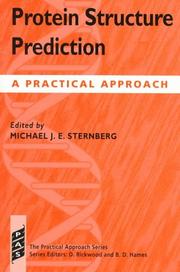
ISBN: 0199634963 0199634971 9780199634972 9780199634965 Year: 1996 Publisher: Oxford IRL Press
Abstract | Keywords | Export | Availability | Bookmark
 Loading...
Loading...Choose an application
- Reference Manager
- EndNote
- RefWorks (Direct export to RefWorks)
The prediction of the three-dimensional structure of a protein from its amino acid sequence is a problem faced by an increasing number of biological scientists. This book provides a practical guide to making these predictions by reviewing strategies of different computer modeling algorithms and highlighting the degree of confidence attributed to them. Also in the volume are descriptions of the following: the principles of protein folding; sequence homology and motif searches; prediction of secondary structure; homology modeling; modeling of antibody combining sites; tertiary fold recognition; modeling of transmembrane proteins; ab initio prediction; protein-ligand docking simulations; and the use of molecular mechanics and dynamics. both non-specialists who require guidance to identify and evaluate appropriate strategies and experts who require a contemporary view of the field, will find this volume a worthy addition to their research libraries.
Human biochemistry --- Proteins --- Conformation --- Computer simulation. --- Protein Conformation --- Computer Simulation --- Computerized Models --- In Silico --- Computer Models --- Models, Computer --- Computer Model --- Computer Simulations --- Computerized Model --- In Silicos --- Model, Computer --- Model, Computerized --- Models, Computerized --- Silico, In --- Silicos, In --- Simulation, Computer --- Simulations, Computer --- Conformation, Protein --- Conformations, Protein --- Protein Conformations --- Protein Folding --- Gene Products, Protein --- Gene Proteins --- Protein --- Protein Gene Products --- Proteins, Gene --- Molecular Mechanisms of Pharmacological Action --- Conformation&delete& --- Computer simulation --- PROTEINS --- LIGANDS --- MODELLING --- ANTIBODIES --- MEMBRANES --- MOLECULAR BIOLOGY --- STRUCTURAL ANALYSIS --- eiwitten --- aminozuursequenties --- amino acid sequences --- nucleotidenvolgordes --- nucleotide sequences --- databanken --- databases --- analytische methoden --- analytical methods --- Proteins and Enzymes --- Eiwitten en enzymen --- Proteids --- Biomolecules --- Polypeptides --- Proteomics --- Proteins - Conformation - Computer simulation.
| Listing 1 - 10 of 24 | << page >> |
Sort by
|

 Search
Search Feedback
Feedback About UniCat
About UniCat  Help
Help News
News